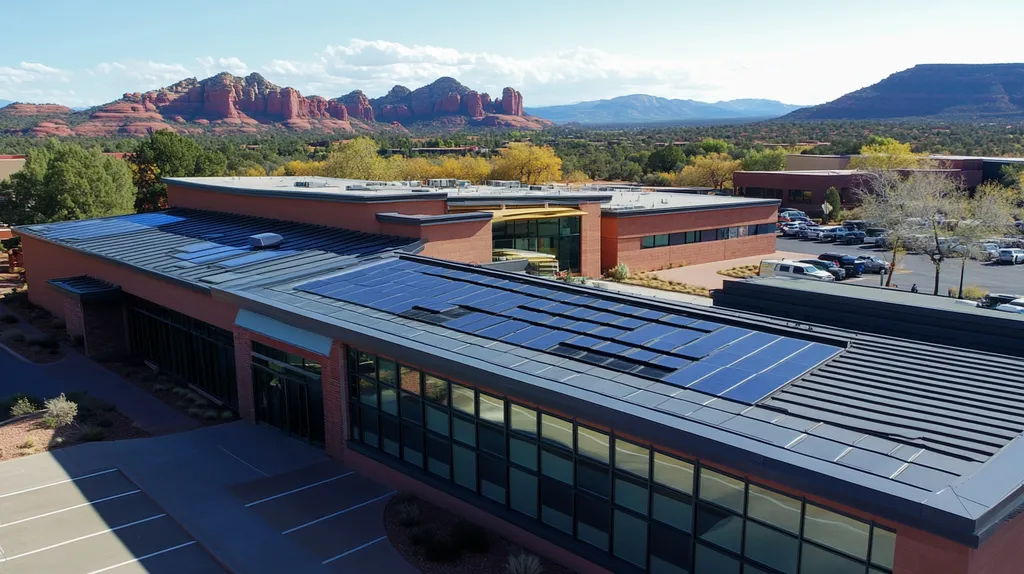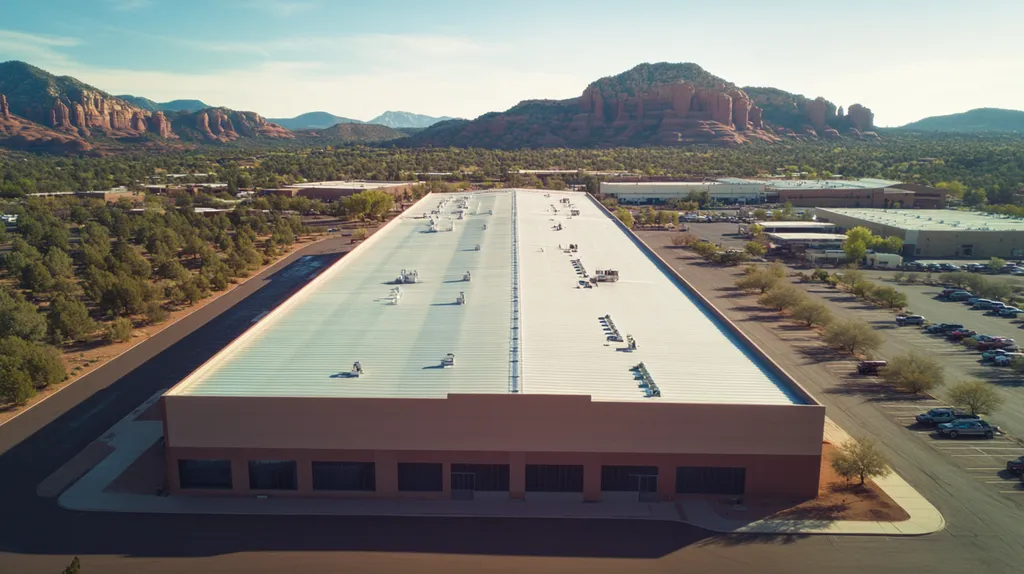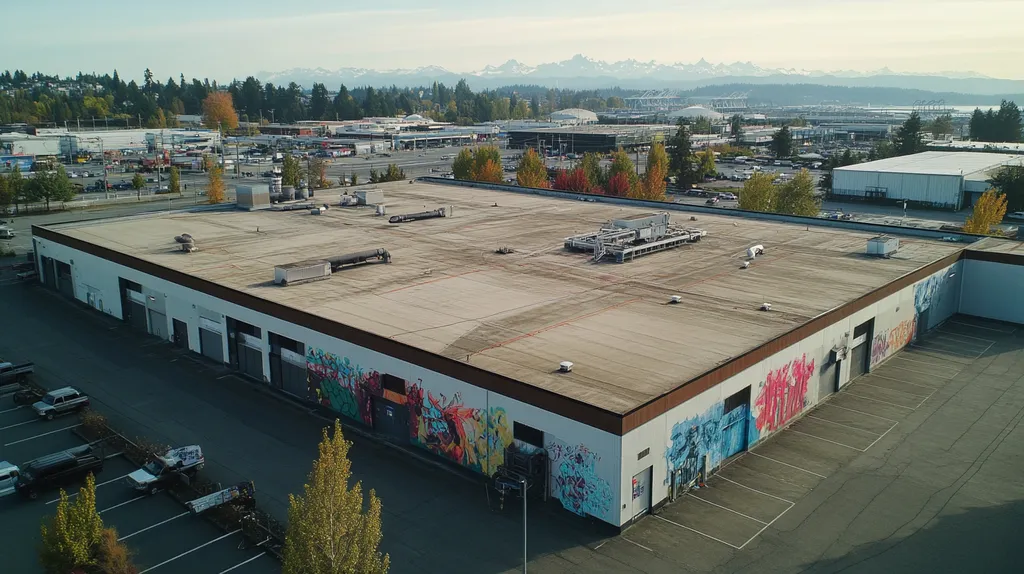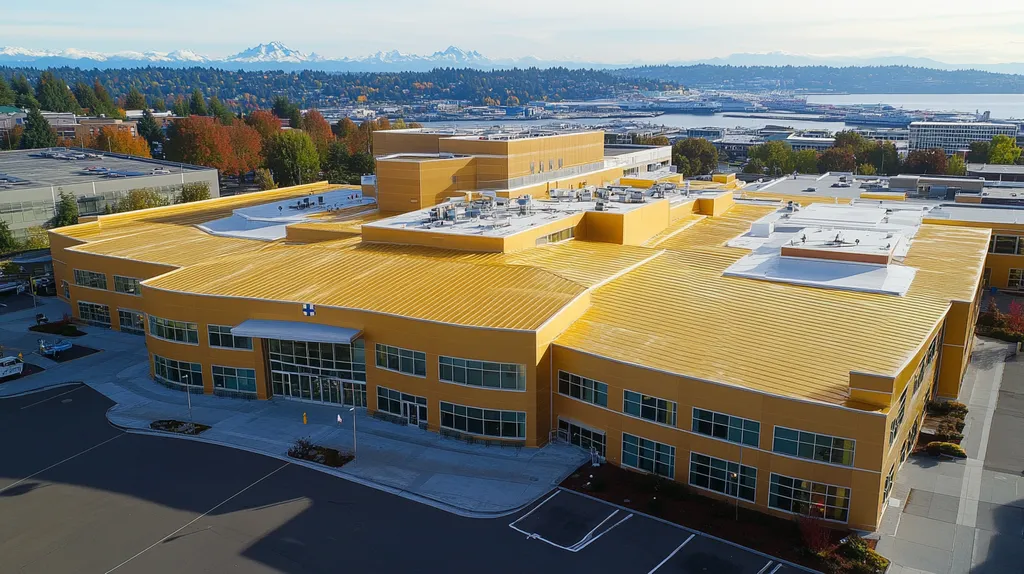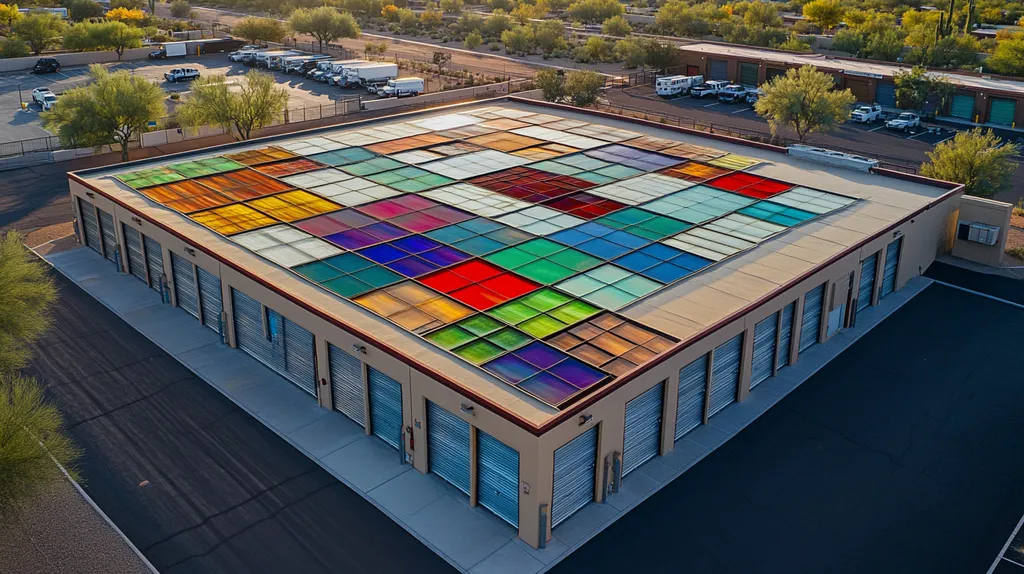Every year, commercial buildings dump millions of tons of perfectly functional roofing materials into landfills during premature replacements. Meanwhile, facility managers struggle with skyrocketing energy costs and mounting pressure to meet sustainability targets.
Roof coatings offer a powerful alternative—transforming aging roofs into energy-efficient assets while extending their lifespan by decades. But success depends on understanding the technology, avoiding common pitfalls, and making informed decisions that protect both budgets and the environment.
This guide breaks down everything property owners need to know about sustainable roof coatings, from basic concepts to expert-level decision-making frameworks.
SECTION 1: THE BASICS EXPLAINED
Picture this: your commercial building’s roof is like a massive umbrella that never gets to close. It’s constantly battling sun, rain, wind, and temperature swings that would make your head spin.
Traditional roofing solutions often mean ripping everything off and starting from scratch—a wasteful, expensive process that fills dumpsters and drains budgets. But roof coatings offer a smarter path forward, turning aging roofs into energy-efficient powerhouses while keeping materials out of landfills.
This approach transforms how we think about commercial roofing maintenance, making sustainability both practical and profitable.
What It Is (In Plain Language)
Think of roof coatings like a superhero suit for your building’s roof. These liquid-applied materials—made from acrylic, silicone, polyurethane, or other advanced polymers—get painted or sprayed directly onto your existing roof surface.
Once they dry and cure, they form a seamless, protective membrane that’s tougher than it sounds. It’s like giving your roof a brand-new skin without the surgery of a full replacement.
This protective layer acts as a shield against UV rays, water infiltration, and daily wear and tear. Instead of your roof slowly deteriorating under constant attack, it gets a fresh lease on life.
The process is surprisingly straightforward compared to traditional roof replacement. No massive construction crews, no weeks of disruption, and no mountains of old roofing materials heading to the dump.
Most coatings work best on flat or low-slope commercial roofs, where they can create that crucial seamless barrier. It’s preventive medicine for your building’s most vulnerable component.
Why It Matters (To Your Building)
Here’s where the magic happens for your bottom line and the planet. Reflective roof coatings can keep roof surfaces up to 55°F cooler than traditional dark roofs, which translates directly into lower air conditioning costs.
Cool roofs help reduce surface and air temperatures by reflecting more sunlight and absorbing less heat compared to traditional roofing materials. This can slash your cooling expenses by 10-15% during peak summer months. (source: Roof Coatings Manufacturers Association)
Beyond energy savings, coatings extend your roof’s lifespan by 10-15 years on average. That’s a decade or more before you need to consider a costly full replacement.
The environmental benefits extend beyond your property line too. Cooler roofs help combat the urban heat island effect, where cities become significantly hotter than surrounding areas.
This means better air quality for your community and reduced strain on the electrical grid during those scorching summer afternoons when everyone cranks up the AC.
How It Works
The coating application starts with a thorough cleaning and inspection of your existing roof. Any cracks, holes, or problem areas get addressed first—think of it as prep work before painting your house.
Once the surface is ready, the coating gets applied in one or more layers, depending on the product and your roof’s condition. The liquid coating flows into small cracks and crevices, sealing them as it cures.
The real science happens with the reflective properties. Special pigments in the coating scatter and reflect solar radiation instead of absorbing it, keeping your roof surface dramatically cooler.
This temperature reduction means your HVAC system doesn’t have to work overtime fighting heat that’s radiating down from above. It’s like putting your building in the shade on a permanent basis.
The best part? When the coating eventually shows signs of wear after many years, you can simply reapply another layer. This creates a sustainable cycle that keeps extending your roof’s life without generating waste.
SECTION 2: PRACTICAL APPLICATIONS
Every day, commercial property owners face a costly choice: tear off aging roofs and fill dumpsters, or find smarter ways to extend what they already have. The construction industry generates over 600 million tons of debris annually, with roofing materials representing a significant chunk of that waste.
Roof coatings offer a practical escape from this wasteful cycle, but only when applied strategically. Understanding the real-world applications, optimal timing, and system compatibility can mean the difference between a coating success story and an expensive lesson learned.
Common Uses & Examples
Picture a massive warehouse with a 20-year-old EPDM rubber roof that’s starting to show its age. Instead of ripping off thousands of square feet of material, a reflective coating can add another decade of life while slashing cooling costs.
Metal roofs on manufacturing facilities represent another coating sweet spot. These roofs expand and contract like accordions in temperature swings, creating stress points where rust loves to start.
A quality coating acts like flexible armor, moving with the metal while blocking moisture and UV rays. It’s particularly effective on corrugated metal roofs where seams create natural weak points.
Aluminum coatings reflect up to 70% of solar radiation, significantly lowering cooling costs and reducing the need for roof replacements that would otherwise send materials to landfills. This makes them a practical solution for both sustainability goals and tight maintenance budgets. (source: Karnak)
Distribution centers and retail buildings with modified bitumen roofs also benefit tremendously from coatings. These dark surfaces absorb heat like solar collectors, making your HVAC system work overtime during summer months.
A white reflective coating transforms these heat magnets into heat reflectors, creating immediate energy savings that often pay for the coating within two to three years.
When You Need It Most
The golden window for roof coatings opens around year 10-15 of your roof’s life, when it’s showing minor wear but hasn’t crossed into serious damage territory. Think of it like getting your car’s paint sealed before rust spots appear.
Facility managers often make the mistake of treating coatings as emergency medicine for dying roofs. By the time you see active leaks or widespread membrane failure, you’ve missed the coating opportunity and entered replacement territory.
Budget cycles also create perfect coating moments. When capital budgets are tight but energy costs are climbing, coatings offer immediate relief without the massive expense of roof replacement.
Regulatory pressure adds another layer of urgency. New energy codes and sustainability requirements can turn yesterday’s adequate roof into today’s liability.
Climate considerations matter too. In sun-baked regions like Arizona or Florida, the cooling benefits of reflective coatings deliver maximum impact, while northern facilities might prioritize coatings for their protective rather than reflective properties.
The worst time for coating? During active leak seasons or when your roof has structural issues that coating can’t address. It’s like putting a band-aid on a broken bone—well-intentioned but ultimately ineffective.
Interactions With Other Systems
Your roof doesn’t exist in isolation—it’s part of a complex ecosystem that includes HVAC equipment, drainage systems, walkways, and potentially solar panels. Coating compatibility with these elements can make or break your project.
Start with substrate compatibility. Silicone coatings work beautifully on EPDM rubber but can cause adhesion nightmares on certain metal surfaces without proper primers.
Drainage becomes critical because coatings change surface textures and water flow patterns. What used to drain properly might now pond water in new locations, creating problems you didn’t have before.
HVAC equipment creates its own challenges. Coatings need to accommodate thermal expansion around unit bases, and you can’t coat over equipment access points or safety features.
Solar installations add another complexity layer. Many coating warranties become void if you install solar panels later, so coordinate these decisions carefully with your sustainability planning.
The key is treating coating projects as whole-building decisions, not just roof maintenance. When done right, coatings integrate seamlessly with existing systems while extending overall building performance and keeping materials out of landfills for years to come.
SECTION 3: KEY TERMINOLOGY DECODED
Walk into any roofing meeting unprepared for the terminology storm, and you’ll quickly find yourself drowning in acronyms, measurements, and technical jargon that can derail sustainable roofing decisions. When facility managers misunderstand terms like “solar reflectance index” or confuse “mils” with “millimeters,” they risk selecting the wrong coatings entirely.
These communication breakdowns cost more than just money—they undermine sustainability goals and延长 the cycle of wasteful roof replacements. Clear terminology knowledge transforms confusing contractor conversations into strategic discussions that support both your building’s performance and environmental responsibility.
Essential Terms Explained
Think of “reflectivity” as your roof’s ability to act like a mirror for sunlight—the higher the percentage, the more solar energy bounces away instead of heating your building. A roof with 80% reflectivity deflects four times more heat than one with 20%, translating directly into cooling cost savings.
“Emissivity” works as your roof’s exhaust system, measuring how efficiently it releases any absorbed heat back into the atmosphere. High emissivity means absorbed heat escapes quickly rather than soaking down into your building like a slow-cooking oven.
“Solar Reflectance Index” or SRI combines both reflectivity and emissivity into a single number that predicts how hot your roof surface will get in full sun. Higher SRI values mean cooler roofs, lower energy bills, and significant contributions to reducing urban heat islands.
“VOC” stands for volatile organic compounds—think of them as chemical hitchhikers that evaporate from coatings and pollute indoor and outdoor air. Low-VOC coatings protect air quality while still delivering the protective performance your roof needs.
Roof coatings have emerged as a key strategy for enhancing energy efficiency and mitigating the environmental effects of urbanization, particularly through the reduction of the urban heat island effect. (source: Roof Coatings Manufacturers Association)
Industry Jargon Translated
“Mil thickness” measures coating depth in thousandths of an inch—not millimeters, which trips up many property managers. A 20-mil coating equals just 0.02 inches, but this thin layer provides years of protection when applied correctly.
“Substrate compatibility” simply means whether your coating will stick properly to your existing roof material. Like trying to tape paper to a wet surface, incompatible combinations lead to coating failures that waste money and materials.
The “recoat window” represents your roof’s sweet spot for adding another coating layer—typically 10-15 years after installation. Miss this window and you’re back to expensive replacement territory instead of sustainable maintenance.
“Adhesion promoter” acts like primer for difficult roof surfaces, creating the chemical bridge between old roofing materials and new coatings. Skip this step on incompatible substrates and watch your coating peel off like old paint.
“Ponding water” describes areas where water sits on your roof for more than 48 hours after rain. Some coatings handle ponding better than others, making this a crucial compatibility factor for flat roof applications.
Measurement & Units Simplified
Coverage rates get expressed in “square feet per gallon,” telling you how much roof area one gallon of coating will cover at the recommended thickness. Accurate coverage calculations prevent material shortages that delay projects or over-ordering that wastes resources.
“Dry film thickness” or DFT measures the coating after water evaporates and solvents escape, leaving only the protective layer behind. Wet film thickness might be twice the dry thickness, so don’t confuse these measurements when planning application.
“R-value” quantifies insulation performance, though most coatings add minimal R-value compared to traditional insulation materials. Understanding this prevents unrealistic expectations about coating thermal performance versus reflective benefits.
“Permeance” measures how much water vapor passes through a coating, expressed in “perms.” Low-perm coatings trap moisture while high-perm products let roofs breathe—choose based on your climate and substrate needs.
Weather resistance gets rated in “cycles” that simulate years of freeze-thaw, UV exposure, and thermal shock in accelerated lab tests. Higher cycle ratings predict longer real-world performance and extended intervals between maintenance coatings.
SECTION 4: DECISION FACTORS
Picture a facility manager staring at three coating proposals with wildly different price tags and performance claims. One costs half the price of another, while the third promises to last twice as long.
These decisions ripple far beyond initial budgets. Commercial buildings waste millions of dollars annually on coating failures that could have been prevented with better decision-making upfront.
The wrong choice doesn’t just hit your wallet—it undermines sustainability goals by creating premature failures, emergency replacements, and unnecessary waste streams that defeat the purpose of choosing coatings in the first place.
Cost Considerations
Think of coating costs like buying shoes—the cheapest pair might get you walking, but they’ll fall apart quickly and cost more in replacements. Premium acrylic coatings might cost 30% more than basic versions, but they often deliver double the lifespan.
Labor represents 40-60% of total coating project costs, making durability even more valuable. When a coating fails after five years instead of fifteen, you’re paying those labor costs again much sooner than planned.
Energy savings create another cost layer that many managers overlook. A high-performance reflective coating that costs $0.50 more per square foot can save $2-3 per square foot in cooling costs over its lifetime.
Some premium coatings qualify for utility rebates or tax incentives that can offset 10-25% of initial costs. These programs specifically reward sustainable choices that reduce energy consumption and extend roof lifecycles.
The hidden cost of cheap coatings shows up in emergency repairs, business disruptions, and the environmental expense of premature material disposal. Factor these risks into your real cost calculations.
Smart budgeting means planning coating renewals during scheduled maintenance windows rather than scrambling for emergency solutions when inferior products fail unexpectedly.
Performance Trade-offs
Every coating type excels in some areas while making compromises in others—like choosing between a sports car and a pickup truck. Silicone coatings resist ponding water beautifully but can be challenging to recoat later without special preparation.
Acrylic coatings offer excellent adhesion and easy recoating but may struggle in areas with frequent standing water. This trade-off becomes critical on roofs with drainage challenges or very low slopes.
Climate compatibility creates another performance balancing act. Coatings that perform wonderfully in dry Arizona heat might fail quickly in humid Florida conditions where moisture resistance becomes paramount.
Reflectivity versus durability presents interesting choices too. Some highly reflective coatings may chalk or fade over time, maintaining their protective qualities while losing some energy-saving benefits.
Substrate compatibility can force performance compromises. The ideal coating for your climate might not adhere properly to your existing roof material without expensive primer systems or surface modifications.
Understanding these trade-offs prevents the common mistake of selecting coatings based on a single impressive specification while ignoring potential weaknesses that could undermine long-term sustainability goals.
Lifespan & Durability Factors
Coating lifespan directly determines how often you’ll generate waste from recoating or replacement projects. A coating that lasts 15 years instead of 8 cuts your material consumption and disposal impact nearly in half.
UV resistance separates long-lasting coatings from quick failures in sunny climates. Superior formulations maintain flexibility and adhesion even after years of intense solar exposure that would crack lesser products.
Some advanced sustainable coatings offer indefinitely repairable systems and lack known lifespan limits, supporting a clean environment by reducing toxic chemicals. (source: Castagra)
Thermal cycling resistance becomes crucial in climates with dramatic temperature swings. Coatings that can flex through daily expansion and contraction cycles without cracking deliver superior longevity.
Manufacturer warranties provide clues about expected durability, but read the fine print carefully. Some warranties cover material defects but exclude normal weathering or application issues that commonly cause premature failures.
The most durable coatings also protect underlying roof systems better, extending the entire roof’s lifespan and delaying the massive waste generation that comes with full roof replacement projects.
SECTION 5: COMMON CHALLENGES
Every year, thousands of commercial buildings lose their coating investments to preventable failures that could have been spotted and stopped early. These failures don’t just waste money—they accelerate the wasteful cycle of premature roof replacements and emergency repairs that coating systems were designed to prevent.
The most expensive coating problems start small and invisible, growing into major sustainability setbacks when facility managers miss the warning signs. Understanding these common challenges transforms reactive maintenance into proactive protection that keeps buildings performing efficiently for decades.
Frequent Problems & Solutions
Picture a warehouse coating that looked perfect for five years before suddenly developing spider web cracks across thousands of square feet. This premature aging often starts with UV degradation that breaks down coating flexibility, especially on south-facing roof sections that bake in constant sunlight.
The solution lies in choosing coatings with superior UV stabilizers and titanium dioxide pigments that reflect rather than absorb damaging solar radiation. Think of these additives as sunscreen for your roof—they cost more upfront but prevent expensive skin damage down the road.
Adhesion failures create another common headache, usually appearing as peeling edges or bubbling sections where coatings lose their grip on the underlying roof. These problems almost always trace back to inadequate surface preparation or moisture trapped during application.
Smart contractors address adhesion issues with thorough cleaning, proper primers, and strict weather windows for application. Skipping these steps to save time or money virtually guarantees coating failures that waste both materials and labor investments.
Ponding water problems plague flat roof coatings when drainage systems can’t keep up with heavy rains. Standard acrylic coatings can soften and degrade when sitting underwater for days, creating weak spots that invite leaks and premature failure.
The fix involves either improving drainage or switching to silicone-based coatings that thrive in wet conditions. This substrate-specific approach prevents water-related failures that can destroy an otherwise sustainable roofing strategy.
Warning Signs To Watch For
Coating problems rarely appear overnight—they broadcast warning signals for months before reaching crisis levels. Chalking represents one of the earliest red flags, showing up as white powder that rubs off when you touch the coating surface.
While minor chalking is normal aging, heavy chalking indicates accelerated coating breakdown that threatens both protective performance and energy-saving reflectivity. Catching this early allows for targeted recoating instead of emergency roof replacement.
Color changes tell important stories too, especially when white reflective coatings start looking gray or yellow. These shifts often signal dirt accumulation, biological growth, or chemical breakdown that reduces cooling benefits and shortens coating life.
Roof coatings have emerged as a key strategy for enhancing energy efficiency and mitigating the environmental effects of urbanization, but only when they maintain their reflective properties over time. (source: Roof Coatings Manufacturers Association)
Physical damage like cracking, blistering, or soft spots requires immediate attention before they allow water infiltration. Small cracks can spread rapidly during freeze-thaw cycles, turning minor repairs into major membrane replacement projects.
Energy bill increases often provide the first clue that coating performance is declining. When cooling costs creep up without obvious HVAC problems, degraded roof reflectivity might be forcing your air conditioning system to work overtime.
Preventative Approaches
The best coating challenges are the ones that never develop, which means building prevention into your maintenance routine from day one. Quarterly visual inspections catch small problems before they become expensive emergencies that derail sustainability goals.
Focus these inspections on high-stress areas like roof penetrations, equipment pads, and drainage points where coatings work hardest. Early detection of edge lifting or membrane exposure allows for spot repairs that cost hundreds instead of thousands.
Annual professional cleaning removes dirt and biological growth that can degrade coating performance and appearance. Power washing with appropriate chemicals restores reflectivity while extending coating life—think of it as routine maintenance that pays dividends.
Climate-specific maintenance schedules prevent seasonal damage before it starts. Northern facilities might focus on freeze-thaw preparation, while southern buildings prioritize UV protection and thermal expansion management.
Documentation creates the foundation for smart preventative decisions by tracking coating performance patterns over time. Photos, temperature readings, and maintenance records help predict when recoating makes more sense than emergency repairs.
Partnering with experienced coating contractors for regular assessments ensures professional oversight that catches problems facility staff might miss. This investment in expertise prevents the costly mistakes that turn sustainable coating systems into wasteful failures.
SECTION 6: NEXT STEPS & RESOURCES
Every coating decision made today determines whether your building becomes part of the sustainability solution or continues feeding the cycle of wasteful roof replacements. With coating technology advancing rapidly and new environmental regulations emerging, facility managers who rely on outdated information risk choosing systems that underperform or fail prematurely.
The difference between coating success and costly failure often comes down to asking the right questions upfront and following proven industry guidelines. Smart property owners use this critical transition point to gather expert insights, validate their approaches against established standards, and build knowledge systems that protect their investments for decades to come.
Questions To Ask Providers
Start every provider conversation by asking about real-world performance data from similar buildings in your climate zone. Generic warranties sound impressive until you discover they don’t cover the specific challenges your roof faces, like ponding water or extreme temperature swings.
Dig deep into application requirements and weather restrictions that could delay your project or compromise coating performance. Some coatings need perfect conditions for days while others handle temperature and humidity variations much better.
Ask about recoat compatibility and long-term maintenance requirements upfront. The cheapest coating today might require expensive removal before future recoating, turning short-term savings into long-term sustainability nightmares.
Request detailed substrate preparation requirements and compatibility testing results. Coating failures almost always trace back to adhesion problems that could have been prevented with proper surface preparation and compatible primer systems.
Finally, verify energy performance claims with actual measured data rather than laboratory projections. Real buildings with real HVAC loads often see different results than controlled testing environments, especially in mixed-use facilities with varying occupancy patterns.
Industry Standards & Guidelines
The Cool Roof Rating Council (CRRC) database provides independently verified reflectance and emittance ratings that cut through marketing claims to reveal actual performance data. These ratings directly predict cooling cost savings and urban heat island reduction benefits.
ASTM International standards like ASTM D6083 establish proper installation procedures that prevent the application mistakes responsible for most coating failures. Following these guidelines protects your investment while ensuring optimal environmental benefits.
Reflective or cool roof coatings reduce the Urban Heat Island Effect and peak energy use which lowers carbon footprints while extending roof life and supporting sustainability goals. (source: Roof Coatings Manufacturers Association)
Energy Star qualification requirements offer another layer of verification for products that deliver proven cooling benefits. These standards help identify coatings that contribute meaningfully to building energy efficiency rather than just claiming environmental benefits.
Local building codes increasingly incorporate cool roof requirements and energy efficiency mandates that affect coating selection. Staying current with these regulations prevents costly compliance issues while maximizing available incentives and rebates.
Further Learning Simplified
Professional development opportunities through organizations like RCI and NRCA provide hands-on training that transforms theoretical knowledge into practical coating expertise. These programs connect facility managers with industry experts who understand real-world challenges.
Manufacturer training sessions offer deep dives into specific product lines and application techniques that can mean the difference between coating success and failure. Most quality manufacturers provide these resources free as part of their technical support.
Industry publications like Professional Roofing and Facility Management keep you current on emerging coating technologies, regulatory changes, and case studies that reveal what works in practice versus theory.
Online resources from the Roof Coatings Manufacturers Association provide technical bulletins, installation guides, and troubleshooting resources that support ongoing coating maintenance and decision-making.
Building relationships with experienced local contractors creates ongoing learning opportunities through real project experience. The best contractors share knowledge freely because educated customers make better decisions that lead to successful projects for everyone involved.
The Bottom Line
Commercial buildings across the country face a critical crossroads: continue the wasteful cycle of premature roof replacements that dump millions of tons of materials into landfills, or embrace coating technologies that extend roof life while slashing energy costs.
The numbers speak clearly—reflective coatings can reduce cooling expenses by 15% while adding 10-15 years to roof lifespan. That’s substantial savings paired with meaningful environmental impact.
Success depends on moving beyond outdated approaches and making informed decisions based on substrate compatibility, climate requirements, and long-term performance data rather than initial cost alone.
Facility managers who act now with proper coating strategies will protect their budgets, meet sustainability targets, and keep functional roofing materials out of landfills for decades to come. Those who wait face escalating energy costs and expensive emergency replacements that benefit no one.
FREQUENTLY ASKED QUESTIONS
Q. What exactly are roof coatings and how do they improve a commercial roof?
A. Roof coatings act like a protective skin that gets applied directly onto your existing roofing surface. They seal cracks, reflect sunlight, and prevent water damage without needing a full roof replacement. Think of it as giving your building’s roof a new superhero suit that extends its life and keeps it cooler.
Q. When is the best time to apply a roof coating on a commercial or industrial roof?
A. The ideal window is around 10-15 years into your roof’s life, before serious damage appears. Applying coatings early prevents costly replacements and maximizes energy savings. Waiting too long is like ignoring rust until it eats through your roof—then coatings won’t help much.
Q. What do key terms like “solar reflectance” and “VOC” mean for my commercial roof?
A. Solar reflectance measures how much sunlight your roof bounces away, which helps keep your building cooler. VOCs are chemicals that can evaporate from coatings and harm air quality. Understanding these terms helps you pick coatings that reduce heat and protect your indoor and outdoor air.
Q. What factors should I consider to choose the right roof coating for my commercial roof?
A. Consider cost vs. lifespan, climate, and how well coatings stick to your roof’s material. Just like buying shoes, cheaper options may wear out fast, costing more over time. Pick coatings that match your local weather, required durability, and save energy to get the best value and sustainability benefits.
Q. What common problems should I watch for with roof coatings on commercial roofs?
A. Look out for peeling, cracks, chalking, and color changes, which often signal coating breakdown. These early warning signs let you fix small issues before they become costly leaks or energy losses. Regular inspections and maintenance keep your roof coating performing longer and protect your investment.
Q. What questions should I ask before hiring a roof coating provider for my industrial roof?
A. Ask about real-world project results, weather requirements for application, and long-term maintenance needs. Verify substrate preparation steps to avoid adhesion problems and request proof of energy savings. These questions ensure your coating lasts and delivers sustainable benefits without surprises.
Q. How do roof coatings support recycling and reduce waste in commercial roofing?
A. Coatings extend your roof’s life by adding protective layers over existing materials, avoiding full tear-offs. This means far less old roofing material ends up in landfills. Think of it as reusing your roof’s “bones” while upgrading its “skin,” cutting waste and lowering environmental impact.

